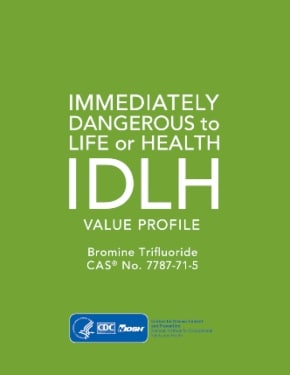Immediately Dangerous to Life or Health (IDLH) Value Profile: Bromine Trifluoride (CAS® No. 7787-71-5)
July 2020
DHHS (NIOSH) Publication Number 2020-123

Overview of the IDLH Value for Bromine Trifluoride
IDLH Value: 12 ppm (67 mg/m3)
Basis for IDLH Value: Data on bromine trifluoride (BrF3) were inadequate to directly derive an IDLH value for BrF3. Data from studies with chlorine trifluoride (ClF3) were used to develop an IDLH value for BrF3 because their chemical structures, reaction mechanisms, and potencies are similar. Therefore, deriving an IDLH value based on the toxicity data for ClF3 is appropriately health-protective. The IDLH value for ClF3 is based on eye irritation in rats at a concentration of 480 ppm exposed for 5 minutes, which was determined to be escape impairing [Horn and Weir 1955]. The duration-adjusted 30-minute concentration is 121 ppm. An uncertainty factor (UF) of 10 was applied to account for interspecies variability (factor of 3) and human variability (factor of 3), resulting in a derived IDLH value of 12 ppm.
Purpose
This IDLH Value Profile presents (1) a brief summary of technical data associated with acute inhalation exposures to ClF3 (a surrogate for BrF3), and (2) the rationale behind the immediately dangerous to life or health (IDLH) value for BrF3, using data from studies with ClF3 as a surrogate. IDLH values are developed based on the scientific rationale and logic outlined in the NIOSH Current Intelligence Bulletin (CIB) 66: Derivation of Immediately Dangerous to Life or Health (IDLH) Values [NIOSH 2013].
Suggested Citation
NIOSH [2020]. Immediately dangerous to life or health (IDLH) value profile: bromine trifluoride, CAS® No. 7787-71-5. By Niemeier RT. Cincinnati, OH: U.S. Department of Health and Human Services, Centers for Disease Control and Prevention, National Institute for Occupational Safety and Health, DHHS (NIOSH) Publication No. 2020-123, https://doi.org/10.26616/NIOSHPUB2020123
